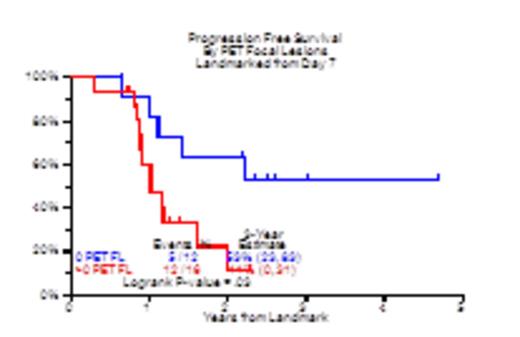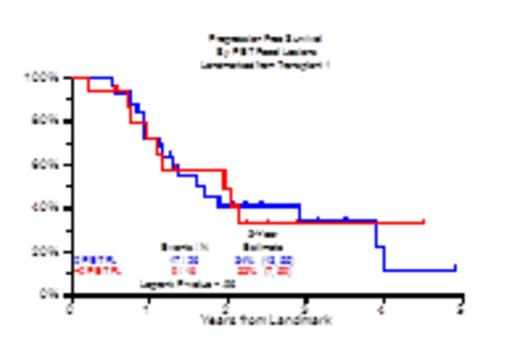Abstract

Introduction:
Fluoro-deoxy-glucose (FDG) positron emission tomography (PET) scanning is an important state-of-the-art imaging tool in the initial workup of patients with multiple myeloma (MM). We evaluate the impact of PET focal lesions (FL) at baseline (BL), 7 days after starting induction therapy (D7) and prior to first autologous transplant (pre-ACST) in gene expression profiling (GEP 70) defined high risk (HR) multiple myeloma (MM) patients.
Patients and methods:
48 GEP 70 HR MM patients were treated uniformly on IRB approved protocol consisting of tandem transplants with dose reduced Mel-80-VRD-PACE (melphalan, velcade, revlimid, dexamethasone, cisplatin, adreamycin, cyclophosphamide and etoposide) and interspersed Mel-20-VTD-PACE (melphalan, velcade, thalidomide, dexamethasone, cisplatin, adreamycin, cyclophosphamide and etoposide) consolidation and VRD (velcade, revlimid, dexamethasone) maintenance. PET examinations were performed at (BL), D7 and pre-ASCT, enumerating FDG-avid FL, their SUV max and extra-medullary disease (EMD).Of the 48 GEP 70 HR patients, 39 had BL, 28 had D7 and 42 had pre-ASCT PET examinations. 20 patients had examinations at all 3 time points. At BL, there were 24 (50%) patients with B2M >5.5mg/L and 26 (54%) with albumin <3.5g/dL. Metaphase cytogenetic abnormalities were documented in 36 (75%) patients, including deletion 13/hypodiploidy in 30 (63%). EMD was present in 3 (8%) patients, 28 (58%) had diffuse SUV <= 2 (median 2.4; range 1.4 to 9.5) and 14 (29%) had FL max SUV >3.9 (median 4.6; range 1.6 to 14.4).
Results:
From BL, the 3-yr PFS estimate was 46% for the group with no FL and 29% for those with FL (Figure 1a). The corresponding PFS data for the D7 was 53% for no FL at D7 as opposed to 11% for those with FL (Figure 1b), and for pre-ASCT it was 34% for no FL and 33% for those with FL (Figure 1c). Joint consideration of BL and D7 landmark revealed 3-yr PFS of 54% for those with no FL at BL, compared to 40% for those with resolution of BL FL by D7 and 18% for those whose FL did not resolve (log rank p-value=0.09), confirming the significance of FL resolution.
Cox regression of PFS revealed that those with FL at BL had 2.34 times the risk of progression or death compared to those with no FL at BL (p=0.075), while those with FL at D7 had 3.27 times the risk (p=0.033). Diffuse SUV and SUV max had no impact on PFS at the three time points.
Fig 1a- PFS from baseline PET Fig 1b- PFS from D7 PET Fig 1c- PFS from pre-ASCT PET
Conclusion:
The prognosis of GEP 70 HR MM is dominantly affected by BL indicators of MM metabolism, as revealed by FDG uptake in FL. Our analysis in HR GEP70 MM patients confirms that early suppression of FL by D7 was key to improved PFS. MM patients who had absence of FL resolution from BL to D7 had poorer PFS and are candidates for early therapy change.
Morgan:Celgene Corp: Membership on an entity's Board of Directors or advisory committees; Novartis: Membership on an entity's Board of Directors or advisory committees; Janssen: Membership on an entity's Board of Directors or advisory committees; Myeloma UK: Membership on an entity's Board of Directors or advisory committees; International Myeloma Foundation: Membership on an entity's Board of Directors or advisory committees; The Binding Site: Membership on an entity's Board of Directors or advisory committees; MMRF: Membership on an entity's Board of Directors or advisory committees. Zangari:Norvartis: Membership on an entity's Board of Directors or advisory committees; Onyx: Research Funding; Millennium: Research Funding. van Rhee:Janssen: Membership on an entity's Board of Directors or advisory committees; Celgene: Membership on an entity's Board of Directors or advisory committees; Millenium: Membership on an entity's Board of Directors or advisory committees; Sanofi: Membership on an entity's Board of Directors or advisory committees.
Author notes
Asterisk with author names denotes non-ASH members.

This icon denotes a clinically relevant abstract




This feature is available to Subscribers Only
Sign In or Create an Account Close Modal